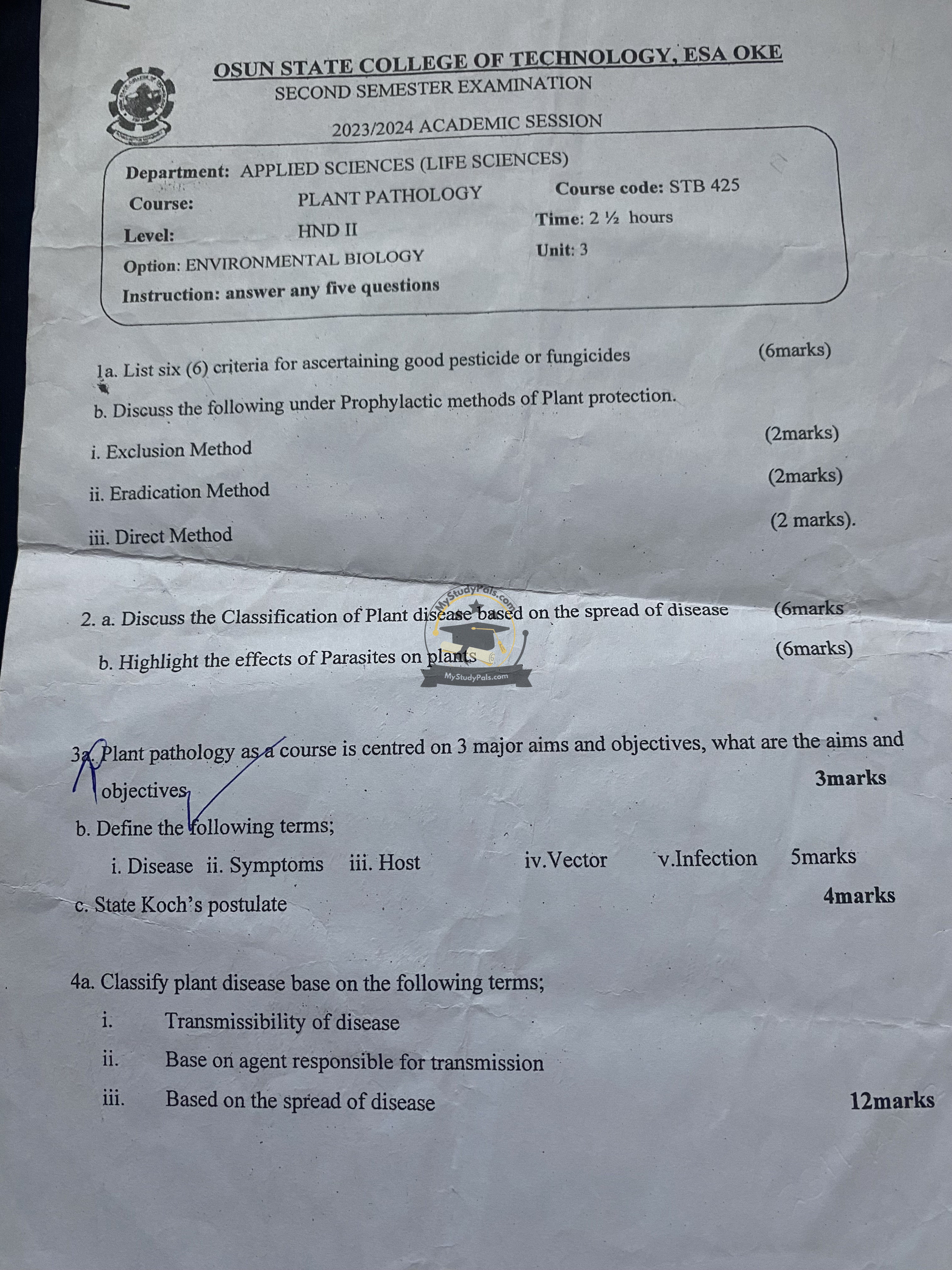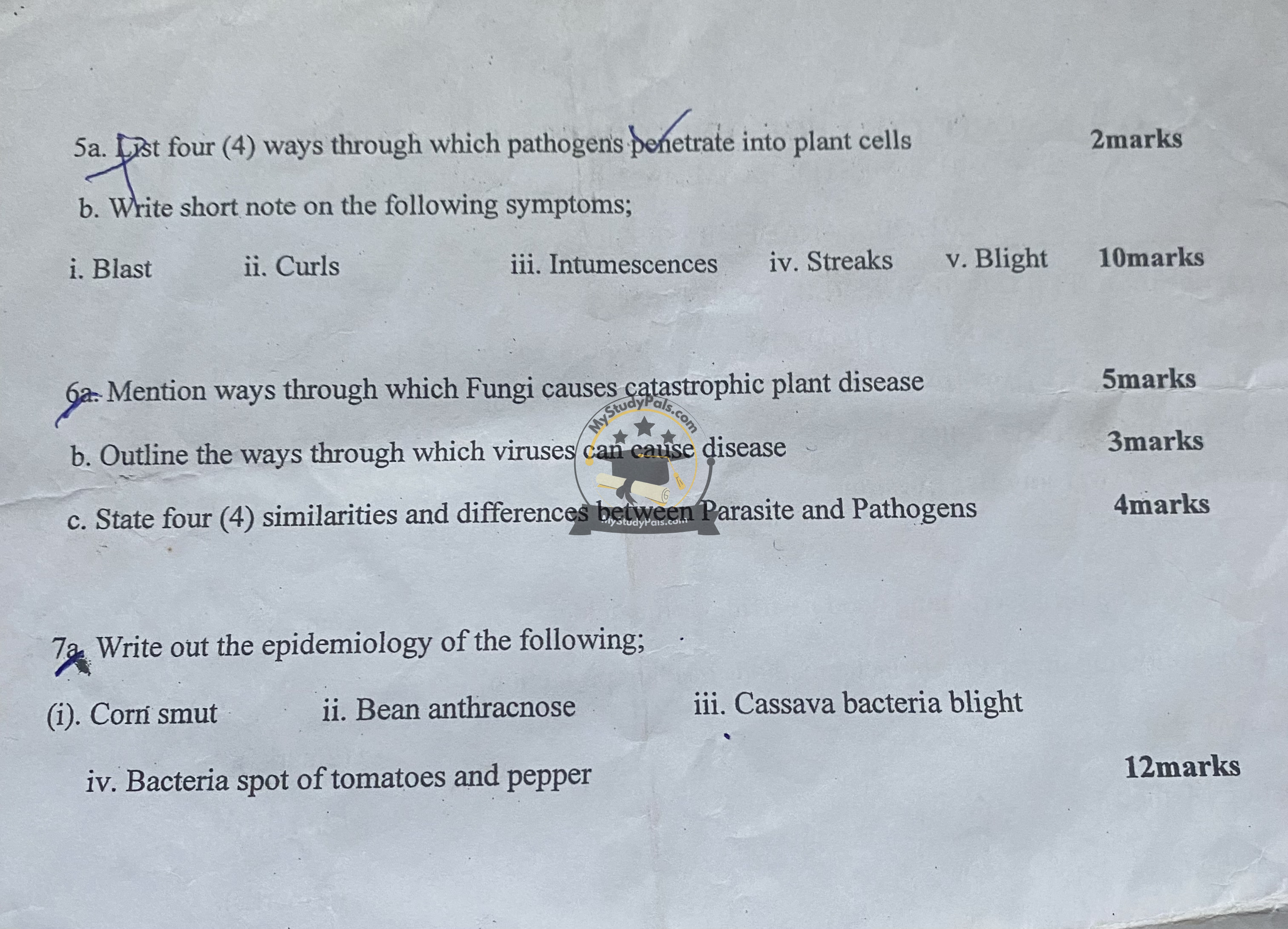ANSWER
Question 1:
a. List six (6) criteria for ascertaining good pesticide or fungicides
Answer:
- Efficacy against target organisms
- Low toxicity to non-target organisms
- Cost-effectiveness
- Stability under various environmental conditions
- Ease of application
- Minimal residue left on crops or the environment
b. Discuss the following under Prophylactic methods of Plant protection.
i. Exclusion Method
Answer: The exclusion method involves preventing the entry of pathogens into an area by applying strict quarantine measures, using pathogen-free planting material, and controlling the movement of potentially infected plants.
ii. Eradication Method
Answer: The eradication method involves removing or destroying infected plants or plant parts, using chemicals to kill pathogens in the soil, or other practices to completely eliminate the source of infection.
iii. Direct Method
Answer: The direct method includes the use of chemicals like fungicides, pesticides, and bactericides to directly target and eliminate the pathogens causing the plant diseases.
Question 2:
a. Discuss the Classification of Plant disease based on the spread of disease.
Answer: Plant diseases can be classified based on their mode of spread:
- Contagious Diseases: Spread through direct contact between plants, either via wind, water, insects, or human activity.
- Non-Contagious Diseases: Caused by non-living factors like nutrient deficiencies, pollutants, or unfavorable environmental conditions, and do not spread from plant to plant.
b. Highlight the effects of Parasites on plants.
Answer: Parasites affect plants by:
- Reducing growth and yield
- Blocking nutrient and water uptake
- Damaging tissues and disrupting physiological functions
- Causing structural deformities
- Leading to premature plant death
Question 3:
a. Plant pathology as a course is centered on 3 major aims and objectives, what are the aims and objectives?
Answer:
- To understand the cause and nature of plant diseases.
- To develop methods for controlling and managing plant diseases.
- To ensure sustainable crop production by protecting plants from diseases.
b. Define the following terms:
i. Disease
Answer: A disease is any deviation from the normal health of a plant caused by a pathogen, leading to physiological dysfunction.
ii. Symptoms
Answer: Symptoms are visible expressions of disease in plants, such as wilting, chlorosis, necrosis, or abnormal growth patterns.
iii. Host
Answer: A host is a plant that provides nutrients and a living environment for a pathogen to grow, reproduce, and cause disease.
iv. Vector
Answer: A vector is an organism (such as an insect or nematode) that transmits a pathogen from one plant to another.
v. Infection
Answer: Infection is the process by which a pathogen enters a plant, establishes itself, and begins to cause disease.
c. State Koch’s postulate.
Answer: Koch’s postulate is a set of criteria to establish that a specific pathogen causes a specific disease. The steps include:
- The pathogen must be present in all diseased plants.
- The pathogen must be isolated and grown in pure culture.
- The isolated pathogen must cause the same disease when introduced into a healthy plant.
- The pathogen must be re-isolated from the newly infected plant.
Question 4:
Classify plant disease based on the following terms:
i. Transmissibility of disease
Answer:
- Infectious Diseases: Caused by pathogens and can be transmitted from plant to plant.
- Non-Infectious Diseases: Caused by abiotic factors (e.g., nutrient deficiencies or environmental stress) and cannot be transmitted.
ii. Base on agent responsible for transmission
Answer:
- Biotic Diseases: Caused by living agents such as fungi, bacteria, viruses, and nematodes.
- Abiotic Diseases: Caused by non-living factors like temperature extremes, water stress, or chemical damage.
iii. Based on the spread of disease
Answer:
- Localized Diseases: Affect specific parts of the plant, like leaves or roots.
- Systemic Diseases: Spread throughout the plant’s system, causing generalized symptoms.
Question 5:
a. List four (4) ways through which pathogens penetrate into plant cells.
Answer:
- Through natural openings like stomata.
- Through wounds caused by physical damage.
- Through insect vectors that create entry points.
- Direct penetration of the plant’s surface by pathogens.
b. Write short notes on the following symptoms:
i. Blast
Answer: Blast is a symptom characterized by sudden death of plant tissues, often caused by fungal infection, leading to wilting and browning of leaves or fruit.
ii. Curls
Answer: Curls refer to abnormal twisting or deformation of plant leaves, often caused by viral infections or pest damage.
iii. Intumescences
Answer: Intumescences are abnormal swellings or overgrowths on plant tissues, usually caused by hormonal imbalances or environmental stress.
iv. Streaks
Answer: Streaks are linear or elongated discolorations on plant stems, leaves, or fruits, often a symptom of viral or bacterial infections.
v. Blight
Answer: Blight refers to a rapid and extensive death of plant tissues, commonly affecting leaves, stems, or fruit, typically caused by fungal or bacterial infections.
Question 6:
a. Mention ways through which fungi cause catastrophic plant disease.
Answer:
- Fungi produce spores that spread through wind, water, or soil.
- Fungi penetrate plant tissues and disrupt their normal functioning.
- Fungi secrete enzymes and toxins that degrade plant cell walls.
- Fungi form mycelium that absorbs nutrients from the host, weakening it.
- Fungi can cause systemic infections that spread throughout the plant.
b. Outline the ways through which viruses can cause disease.
Answer:
- Viruses enter plants through wounds, insect vectors, or mechanical injury.
- Once inside, viruses hijack the plant’s cellular machinery to reproduce.
- Viruses disrupt normal cellular processes, leading to stunted growth, discoloration, and deformities.
- They interfere with nutrient transport, causing symptoms like yellowing or necrosis.
c. State four (4) similarities and differences between Parasite and Pathogens.
Similarities:
- Both can cause diseases in plants.
- Both require a host to survive and reproduce.
Differences:
- Parasites are typically organisms like insects, while pathogens include bacteria, fungi, viruses, and nematodes.
- Pathogens can cause systemic diseases, while parasites may cause localized damage.
- Pathogens can often multiply within the host, while parasites may not.
- Parasites are usually visible to the naked eye, while pathogens are microscopic.
Question 7:
Write out the epidemiology of the following:
i. Corn smut
Answer: Corn smut is caused by the fungus Ustilago maydis, which infects corn and causes tumor-like galls on ears, stalks, and leaves. It spreads through windborne spores and thrives in warm, humid environments.
ii. Bean anthracnose
Answer: Bean anthracnose is caused by the fungus Colletotrichum lindemuthianum, leading to dark lesions on stems, pods, and leaves. The disease spreads through contaminated seeds, rain splash, and wind.
iii. Cassava bacterial blight
Answer: Cassava bacterial blight is caused by Xanthomonas axonopodis pv. manihotis, resulting in leaf blight, wilting, and dieback of cassava plants. It spreads through contaminated soil, water, and plant materials.
iv. Bacterial spot of tomatoes and pepper
Answer: Bacterial spot is caused by Xanthomonas campestris pv. vesicatoria, leading to dark, water-soaked lesions on leaves, stems, and fruits. It spreads through rain splash, wind, and contaminated seeds or transplants.



